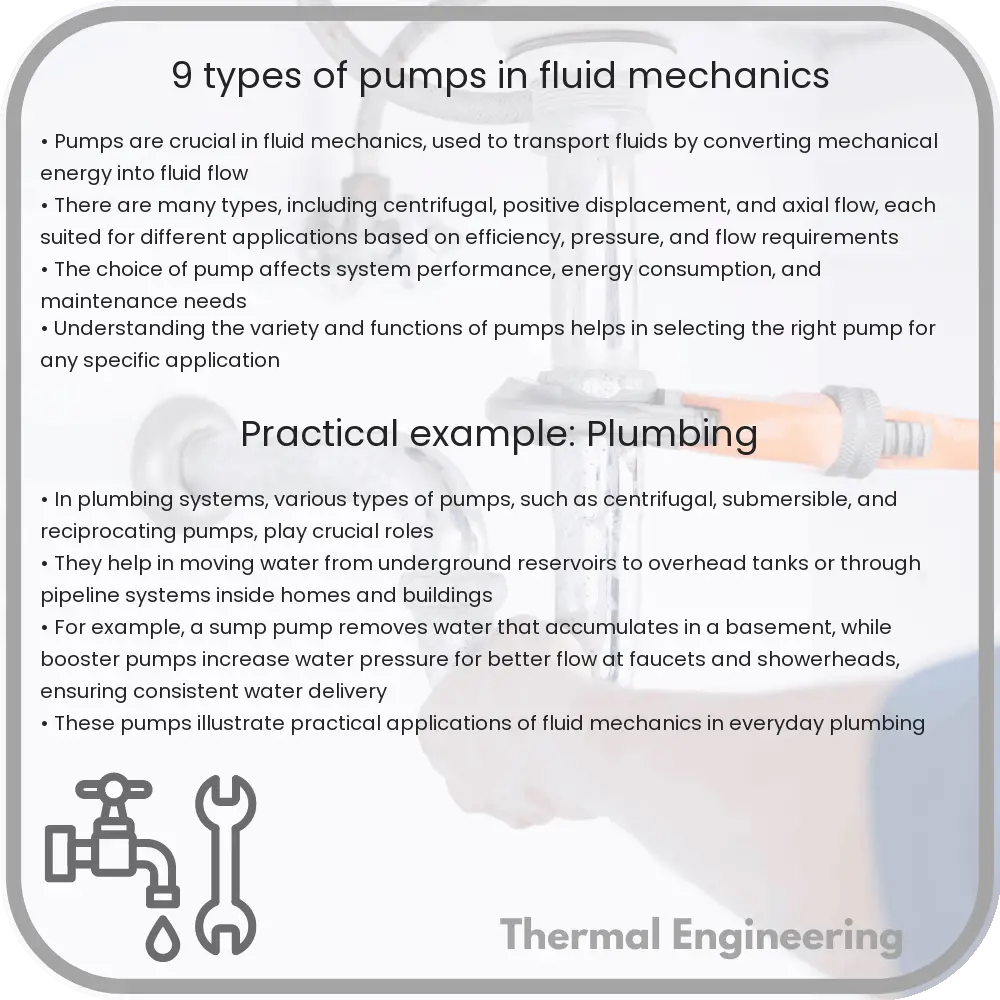Learn about the various types of pumps used in fluid mechanics, including centrifugal, diaphragm, and positive displacement pumps, each suited for specific industrial applications.

Introduction to Types of Pumps in Fluid Mechanics
Pumps are essential devices in fluid mechanics, used primarily to transport liquids from one location to another. They play crucial roles in various industries such as water treatment, oil and gas, chemical processing, and more. Pumps are categorized based on their operational mechanisms and the applications they suit. Understanding these classifications helps in choosing the right pump for the right job.
Centrifugal Pumps
This is the most common type of pump, characterized by the use of a rotating impeller to accelerate fluid outward from the center of rotation. The fluid gains both speed and pressure as it moves through the impeller. Centrifugal pumps are typically used for large discharge throughputs and where the fluid pumping does not contain air or vapors.
Positive Displacement Pumps
Positive displacement pumps move a fixed amount of fluid with each operation cycle. They provide a steady and consistent flow regardless of the system pressure, making them ideal for applications requiring precise volume management. This category includes gear pumps, screw pumps, and piston pumps, each using a different mechanism to trap the fixed volume and force it into the discharge pipe.
Diaphragm Pumps
Also classed as a type of positive displacement pump, diaphragm pumps use a flexible membrane that reciprocates back and forth, creating a variable-volume chamber on one side of the membrane and controlling fluid movement. They are particularly useful for handling hazardous, toxic, or corrosive fluids, as the fluid does not come into contact with moving parts.
Submersible Pumps
These pumps are completely submerged in the fluid they are pumping. They are commonly used for pumping water from wells, removing bilge water from ships, and in other applications where the pump can be completely immersed. Submersible pumps are efficient in deep water installations, avoiding the need for complex suction mechanisms.
Jet Pumps
Jet pumps employ high velocity to capture fluid and transport it. They often mix the drive fluid with the fluid being pumped, which increases the velocity of the fluid mixture. Jet pumps are particularly effective in applications involving the extraction of liquids from considerable depths, such as wells.
Gear Pumps
A type of positive displacement pump where the fluid is enclosed within the cavities of rotating gears or between the gear teeth. This action pushes fluid to the pump outlet with minimal pulsations. Gear pumps are ideal for pumping viscous fluids or oils.
Screw Pumps
These operate using one or more screws to move fluids along the screw axes. They provide a smooth, consistent flow and are used in applications requiring high pressures and flow rates. Screw pumps are often employed in heavy machinery cooling systems and in the oil and gas industry.
Peristaltic Pumps
Peristaltic pumps contain fluid within a flexible tube or hose, fitted inside a circular pump casing. As a rotor compresses the tube, the fluid is pushed forward. This design eliminates the risk of pump contamination and is used extensively in medical, laboratory, and bioprocessing fields.
Piston Pumps
Piston pumps are a type of positive displacement pump where the high-pressure seal reciprocates with the piston. These pumps are often used where high consistent pressure is required, and they are common in industries involving the production of high-pressure washing systems and in hydraulic systems.
Conclusion
Understanding the different types of pumps used in fluid mechanics can greatly enhance the efficiency and effectiveness of fluid transport and handling in various industrial applications. Each type of pump is suited to specific conditions and requirements, making knowledge of their operations critical for proper selection and maintenance.